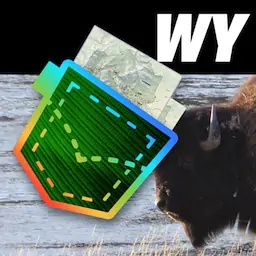"Grand Teton, Moose Entrance" by U.S. National Park Service , public domain
MammalsNature |
Mammals brochure for Grand Teton National Park (NP) in Wyoming. Published by the National Park Service (NPS).
featured in
| National Parks Pocket Maps |  | |
| Idaho Pocket Maps |  | |
| Wyoming Pocket Maps |  | |
| Yellowstone Pocket Maps |  |
Grand Teton
National Park Service
U.S. Department of the Interior
Grand Teton National Park
John D. Rockefeller, Jr.
Memorial Parkway
Mammals
The diverse wildlife in Grand Teton National Park and the
John D. Rockefeller, Jr. Memorial Parkway complements
the spectacular scenery. As part of the Greater Yellowstone
Ecosystem, these two national parks contain numerous
communities. Each community must supply the basic needs
of wildlife: food, water, shelter and space. Familiarity with
wildlife communities and behaviors allows you to improve
your chance of viewing these animals in their environment.
Communities
Alpine
Elevation, wind, harsh winters and brief summers
force the plants and animals living here to adapt.
Plants grow as mats and animals are few. Look for
yellow-bellied marmots, pikas and bighorn sheep
seeking shelter in rocky outcrops.
Forests
From treeline to valley floor, forests provide cover
and food for many mammal species. Lodgepole
pines dominate, but forests also contain other
pines, firs, aspens and spruces. Look for elk,
mule deer, martens, red squirrels, black bears and
snowshoe hares.
Where to Look:
Driving and Hiking
Northern Jackson Lake
Highway 89/191/287 follows the eastern shore of
Jackson Lake north of Colter Bay. Enjoy a view of
the Teton Range and look for wildlife in the aspen
groves and meadows alternating with extensive
conifer forests. Lush meadows attract mule deer
and elk, while the lake attracts American white
pelicans, Canada geese and other waterfowl.
Colter Bay
Sagebrush, meadows and forests provide habitat
for many mammals. Deer feed at the edge of
conifer forests. Uinta ground squirrels flourish
in dry sagebrush meadows, while red squirrels
chatter incessantly from conifer forests. Look for
occasional snowshoe hares and martens. Trails
lead to ponds inhabited by beavers, muskrats,
waterfowl and river otters, or may provide a view
of bear, moose or elk.
Willow Flats
North of the Jackson Lake Dam moose browse
on willow shrubs. At dawn and dusk, elk graze on
grasses growing among willows. Predators such
as wolves and grizzly bears pursue elk calves in
early summer. Beavers create ponds by damming
streams that also harbor muskrats and waterfowl.
Oxbow Bend
The slow-moving water of this cut-off meander
of the Snake River provides habitat for fish such
as suckers and trout that become food for river
otters, beaver and muskrats. Moose browse on
abundant willows at the water’s edge. Elk graze
in the open aspen groves to the east while grizzly
bears occasionally look for prey.
Teton Park Road
Extensive sagebrush flats are interspersed with
stands of lodgepole pines and aspens. Pronghorn
Sagebrush
Sagebrush flats occur on semi-arid, rocky soils
covering the valley floor. More than 100 species
of grasses and wildflowers flourish along with
sagebrush. Lack of cover makes large animals
conspicuous. Look for pronghorns, coyotes, bison,
badgers, elk and Uinta ground squirrels.
Rivers, Lakes and Ponds
Aquatic habitats and adjacent forests, marshes
and meadows fulfill the needs of many forms of
wildlife. Diverse and abundant vegetation offers
excellent food and cover. Look for moose, river
otters, beavers, muskrats, coyotes and mule deer.
gather in small groups where they browse on
sagebrush. Black bears cross between forests and
plains. At dawn and dusk look for elk grazing on
grasses on the forest edge.
Snake River
This riparian area attracts a variety of wildlife. Elk
and bison graze in grassy meadows along the river.
Bison also eat grasses in the sagebrush flats on the
benches above the river. Moose eat willows that
line the waterway, and beaver strip bark.
Blacktail Ponds
This turnout is located 0.5 mile north of Moose
Junction on Highway 26/89/191. Old beaver ponds
have filled in and now support grassy meadows
where elk graze during cool parts of the day.
Moose browse on willows growing along the river.
Two Ocean and Emma Matilda Lakes
Elk graze during dawn and dusk, and seek refuge
from the heat of the day in nearby forests. Moose
browse on willows growing along the lakeshore.
Mule deer, coyotes, black and grizzly bears,
martens and red squirrels also frequent this area.
Cascade and Death Canyons
Look and listen for pikas and marmots in boulder
fields along the trails. Moose browse on willows
and other shrubs growing along creeks. Black
bears frequent the canyons and grizzly bears are
becoming more common.
Taggart Lake and Beaver Creek
Willows growing along Beaver Creek provide food
for moose. Elk graze on lush grasses and deer
browse on shrubs while black bears sometimes
frequent the area.
Mammal List
Order Artiodactyla (Even-toed Ungulates)
Antilocapridae – Pronghorn Family
c Pronghorn Antilocapra americana
Order Lagomorpha (Rabbits and Hares)
c American Pika Ochotona princeps
c Snowshoe Hare Lepus americanus
Bovidae – Cattle Family
c Bison Bos bison
r Mountain Goat Oreamnos americanus
u Bighorn Sheep Ovis canadensis
Order Rodentia (Gnawing Mammals)
c Yellow-pine Chipmunk Neotamias amoenus
c Least Chipmunk Neotamias minimus
r Uinta Chipmunk Neotamias umbrinus
c Yellow-bellied Marmot Marmota flaviventris
a Uinta Ground Squirrel Spermophilus armatus
c Golden-mantled Ground Squirrel
Spermophilus lateralis
c Red Squirrel Tamasciurus hudsonicus
r Northern Flying Squirrel Glaucomys sabrinus
c Northern Pocket Gopher Thomomys talpoides
c American Beaver Castor canadensis
a Deer Mouse Peromyscus maniculatus
c Bushy-tailed Woodrat Neotoma cinerea
r Western Heather Vole Phenacomys
intermedius
a Meadow Vole Microtus pennsylvanicus
a Montane Vole Microtus montanus
a Long-tailed Vole Microtus longicaudus
u Water Vole Microtus richardsoni
r Sagebrush Vole Lemmiscus curtatus
c Southern red-backed vole Clethrionomys
gapperi
c Common Muskrat Ondatra zibethicus
u Western Jumping Mouse Zappus princeps
c North American Porcupine Erethizon
dorsatum
Cervidae – Deer Family
a Elk (wapiti) Cervus elaphus
c Mule Deer Odocoileus hemionus
u White-tailed Deer Odocoileus virginianus
c Moose Alces alces
Order Carnivora (Meat eaters)
Canidae – Dog Family
a Coyote Canis latrans
u Gray Wolf Canis lupus
u Red Fox Vulpes vulpes
Felidae – Cat Family
r
Mountain Lion (Puma) Felis concolor
o Canada Lynx Felis lynx
r Bobcat Felis rufus
Mustelidae – Weasel Family
u American Marten Martes americana
c Short-tailed Weasel Mustela erminea
r Least Weasel Mustela nivalis
c Long-tailed Weasel Mustela frenata
u American Mink Mustela vison
r Wolverine Gulo gulo
c American Badger Taxidea taxus
c Striped Skunk Mephitis mephitis
u North American River Otter Lontra
canadensis
Procyonidae – Raccoon Family
u
Northern Raccoon Procyon lotor
Ursidae – Bear Family
c Black Bear Ursus americanus
c Grizzly Bear Ursos arctos
Order Chiroptera (Bats)
u Long-eared Myotis Myotis evotis
a Little Brown Bat Myotis lucifugus
c Long-legged Myotis Myotis volans
u Hoary Bat Lasiuris cinereus
c Silver-haired bat Lasionycteris
noctivagans
c Big Brown Bat Eptisicus fuscus
r Townsend’s big-eared bat Corynorhinus
townsendii
r Fringed myotis Myotis thysanodes
Etiquette for Wildlife
Viewing
BEAR
AWARE
FOOD
STORAGE
REQUIRED
Do not approach or harass wildlife.
• Use binoculars, a spotting scope or long camera
lens for close-up views and photographs.
• Maintain a distance of at least 100 yards from
bears and wolves, and 25 yards from all other
wildlife. Do not position yourself between an
adult and its offspring; adults may attack.
• Never touch, pick up or disturb young. Mothers
will sometimes leave their offspring temporarily
while they search for food.
• If your actions cause an animal to flee, you are
too close. You have also deprived other visitors
of a viewing opportunity.
BEAR
AWARE
Do not feed wildlife.
Feeding wild animals including ground squirrels
and birds makes them
dependent on people.
FOOD
KEEP
Normal behavior
and nutrition may be altered and
STORAGE
FOOD
could impact anREQUIRED
animals’ ability to survive winter.
STORED
Habituation to people may result in aggressive
behavior for all animals.
E X P E R I E N C E Y O U R A M E R I C A™
Order Soricomorpha – Shrew Family
c Masked Shrew Sorex cinereus
c Dusky Shrew Sorex monticolus
r Dwarf Shrew Sorex nanus
u American Water Shrew Sorex palustris
r Preble’s Shrew Sorex preblei
u Vagrant Shrew Sorex vagrans
Symbol Key
a Abundant – likely to be seen in appropriate
habitat and season.
c Common – frequently seen in appropriate
habitat and season.
u Uncommon – seen irregularly in appropriate
habitat and season.
o
Occasional – seen only occasionally in
appropriate habitat and season.
r
Rare – unexpected even in appropriate habitat
and season.
Species list and abundance categories based on
NPS Species List accepted status and occurrence
research report.
Bear Safety
Black and grizzly bears live throughout the park
and may be active at any time. Follow these
precautions or ask a ranger for more information:
• Do not allow bears to obtain human food. This
may result in aggressive behavior. Often then the
bear becomes a threat and must be destroyed.
• Avoid encounters. Make noise such as clapping,
shouting or singing so bears are aware of your
presence. Be especially careful in dense brush or
along streams where bears may not hear you.
• Do not run from a bear. Running may elicit an
attack. If the bear is unaware of you, change
your route to avoid the bear. If the bear is aware
of you but not aggressive, back away slowly,
talking in an even tone.
• If a bear charges, stand still, do not run. Bears
often “bluff charge,” stopping before contact.
Remain still until the bear stops, then back away
slowly. Do not drop your pack; it may protect
your body if attacked.
rev. 11/2012




